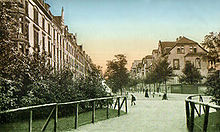Buchrainweg
| Buchrainweg | |
|---|---|
| Street in Offenbach am Main | |
| The Buchrainweg, looking east | |
| Basic data | |
| place | Offenbach am Main |
| District | Downtown |
| Newly designed | 2001 and 2008 (sections) |
| Buildings | Wilhelm Schramm pen |
| Technical specifications | |
| Street length | 1,400 meters |
The Buchrainweg is a 1,400 meter long road in the south of the city of Offenbach parallel to the arterial road Sprendlinger highway after Sprendlingen .
course
The road begins near the Sana Klinikum Offenbach and leads west of it towards the city forest. After the Odenwaldring, the street is a traffic-calmed zone.
history
The name goes back to the Buchrainweiher, which is not far from the end of the road in the city forest. Before the road was built, Buchrainweg was a corridor boundary and is made up of beech and rain . The route is first mentioned in 1773. The development plan was drawn up by Hugo Eberhardt (1874–1959).
use
Although not part of Offenbacher Westend, the street and especially the eastern part is one of the residential streets with an upscale residential area. Many personalities have lived there. The economist Erich Gutenberg lived in house number 20 in the 1960s. At house number 29, a plaque designed by Karlgeorg Hoefer commemorates the designer and type designer Rudolf Koch , who lived there from 1908 until his death in 1934.
House No. 135 is home to the Wilhelm Schramm Foundation for the elderly and nursing home , built in the so-called "Offenbach Art Nouveau" style by Hugo Eberhardt. The painter Karl Friedrich Lippmann lived in house number 161, and Klaus Vack coordinated its activities there at the first seat of the German Easter March movement .
Development
The development of the eastern part originates largely from the Wilhelminian era and is mostly two to three storeys on the northern side of the street and mostly higher on the southern side. Many buildings were built by the construction companies H. and L. Nagel and the Beck brothers .
The northern side is loosened up by individual villas. An outstanding villa stands at the confluence with Blumenstrasse, which was designed by the church builder Dominikus Böhm (1880–1955). At the intersection with Taunusring is a residential complex made up of two high-rise buildings. After that the development consists only of single houses.
Today the eastern part of the development along the street is a listed building as a whole.
- Buildings along the street from east to west
Web links
Individual evidence
- ↑ Helmut von der Heiden: Who's who in the common market's press and advertising , 1965, p.
- ↑ State Office for the Preservation of Monuments Hesse (ed.): Buchrainweg 27/29 In: DenkXweb, online edition of cultural monuments in Hesse .
- ↑ The forgotten day of death. On: op-online.de , from August 27, 2009, accessed on November 4, 2013.
- ↑ Adolf Hoffmann: Entomologen-Adressbuch: Annuaire des entomologistes , p. 66, 1921 (via Google Books)
- ↑ Preparation of the Easter March 1968. On: fes.de ( Friedrich-Ebert-Stiftung ), accessed on December 4, 2013.
- ↑ State Office for the Preservation of Monuments Hesse (ed.): Buchrainweg In: DenkXweb, online edition of cultural monuments in Hesse .
Coordinates: 50 ° 5 ′ 37.1 ″ N , 8 ° 44 ′ 52.5 ″ E





